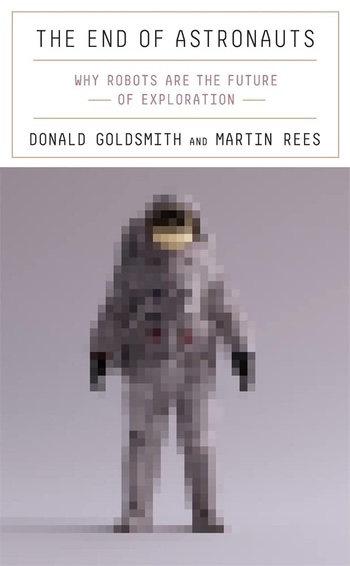Review: The End of Astronautsby Jeff Foust
|
| Goldsmith and Rees argue that AI can close the gap between robotic and human capabilities in space exploration. |
The report, while focused on robotic missions, also examined the potential for human exploration, particularly of the Moon through NASA’s Artemis program, to support planetary goals. It offered a cautionary note: “Currently, science requirements do not drive the Artemis capabilities. However, in the committee’s view it is imperative that Artemis support breakthrough, decadal-level science.” [emphasis in original] However, it endorsed one mission that combined robotic and human capabilities: a robotic rover called Endurance-A that would travel more than 1,000 kilometers across the South Pole-Aitken Basin, collecting 100 kilograms of samples that would be delivered to an Artemis lander for astronauts to return to Earth.
For the last couple of decades, there has been a truce between advocates of robotic and human space exploration, with an acknowledgement that the two can and should work together: robots serving as precursors and assistants for later human missions. But in The End of Astronauts, Donald Goldsmith and Martin Rees—a veteran science writer and the UK’s Astronomer Royal, respectively—argue that exploration beyond Earth orbit should be left to robots, a case that is certainly controversial but not necessarily compelling.
If that sounds like a familiar argument, it should be: Rees, for example, has been skeptical in the past about the benefits of human space exploration. The authors lay out the standard arguments against human missions, such as the cost and risk of sending humans to the Moon, Mars, or elsewhere. Robotic missions cost far less and their capabilities have been growing throughout the Space Age.
In particular, Goldsmith and Rees argue that artificial intelligence (AI) can close the gap between robotic and human capabilities. Future advances in AI, they claim, will enable robotic missions to effectively operate independently, collecting and returning data with little human interaction that today is required and thus slows the pace of missions like Mars rovers.
They overplay their hand with AI triumphalism, though. They cite a 2012 paper by one planetary scientist, Ian Crawford, who examined 18 different skills related to exploration and found human superior in 13 of them and tied with robots in another. No matter: “Current trends in artificial intelligence suggest that of the thirteen categories judged to favor humans in 2012, humans will remain on top in only a couple of them twenty to thirty years later: cognition and decision-making,” they argue, without offering any substantiation of that argument.
| The authors write, for example, that the Columbia disaster took place in 2013 (no, 2003) and that former astronaut Scott Kelly is now a US senator (no, it’s his twin brother, Mark.) |
That’s important because the progress of general-purpose AI has lagged predictions of its impending ascendence for decades, much like fusion power (the authors, for good measure, mention the moon as a source of helium-3 for fusion power without mentioning the lack of reactors that can use it.) Applications like self-driving cars—a sophisticated, but narrow, use of AI—have failed to keep pace with the statements of advocates, including Elon Musk, who acknowledged in a recent TED conference interview that Tesla’s work on self-driving cars fell short of goals he set for it. Given the limited applications of AI so far in missions, like the “AutoNav” feature to enable longer autonomous drives by the Perseverance rover, and the long development cycles for planetary missions, it’s hard to see AI advancing as quickly as the authors predict, undermining their case.
There is also a sloppiness with the overall book. There are many factual errors, mostly minor ones. The authors write, for example, that the Columbia disaster took place in 2013 (no, 2003) and that former astronaut Scott Kelly is now a US senator (no, it’s his twin brother, Mark.) In an early chapter they claim that SpaceX delivers cargo to the International Space Station for $1,250 per pound, but says in a later chapter the figure is $8,000 per pound. (Both are wrong: a NASA Office of Inspector General report in 2018 estimated the cost for both SpaceX and Northrop Grumman at $63,200 per kilogram, or $28,700 per pound, for the original series of cargo contracts; the authors, perhaps, included the mass of the spacecraft in their calculations, which NASA is not paying for.) Combined, the errors don’t give the reader much confidence in the arguments they make. Perhaps the authors were waiting for a fact-checking AI system.
Of course, governments don’t send astronauts into space exclusively or even primarily to do exploration: it’s one rationale of several, like geopolitics and national prestige. Goldsmith and Rees appear to acknowledge this, expecting the US and China to land humans on the Moon in the next decade or so, with Mars missions possibly by the 2040s but perhaps later.
The solar system is a pretty big place. Many of the destinations outlined in the planetary science decadal survey remain out of reach of human explorers for the indefinite future: it’s unlikely any contemporary reader will still be alive if humans do, one day, set foot on Enceladus or go into orbit around Uranus. If humans are already going to space, for prestige or profit, there’s room for them to do exploration as well, working with, and building upon, robotic counterparts.
Note: we are using a new commenting system, which may require you to create a new account.
